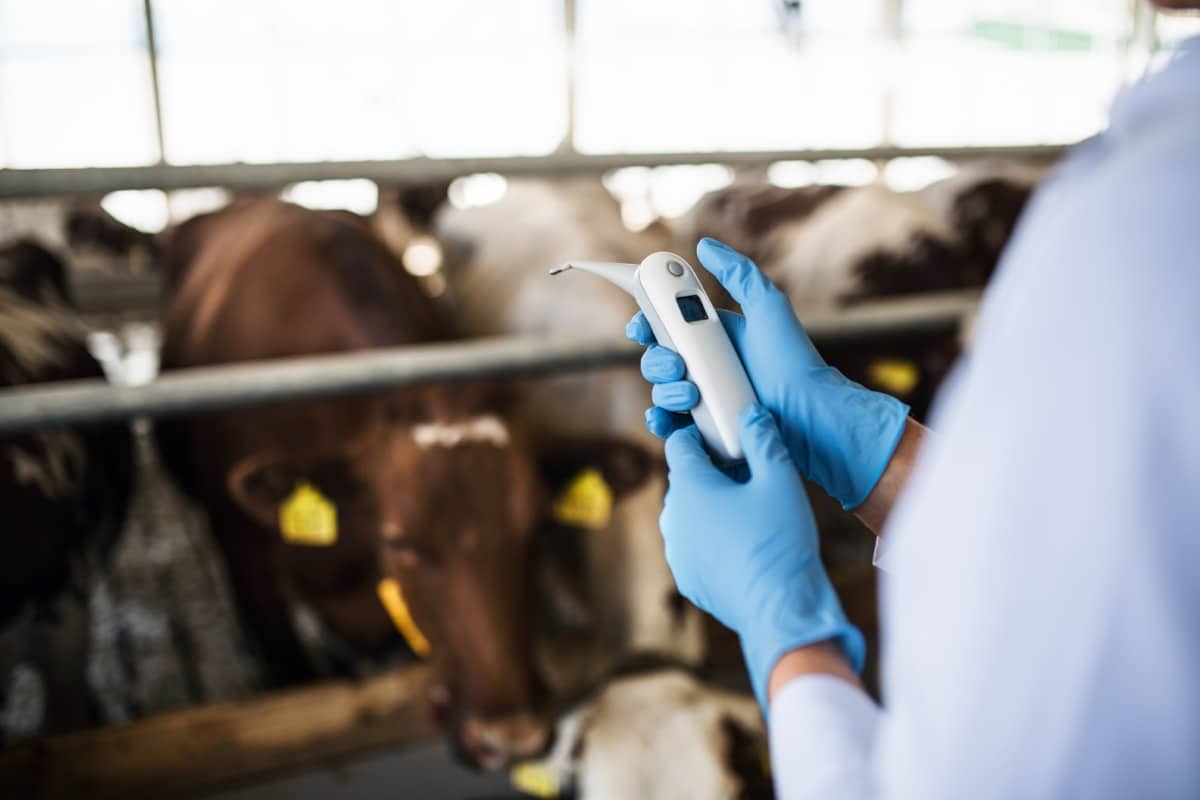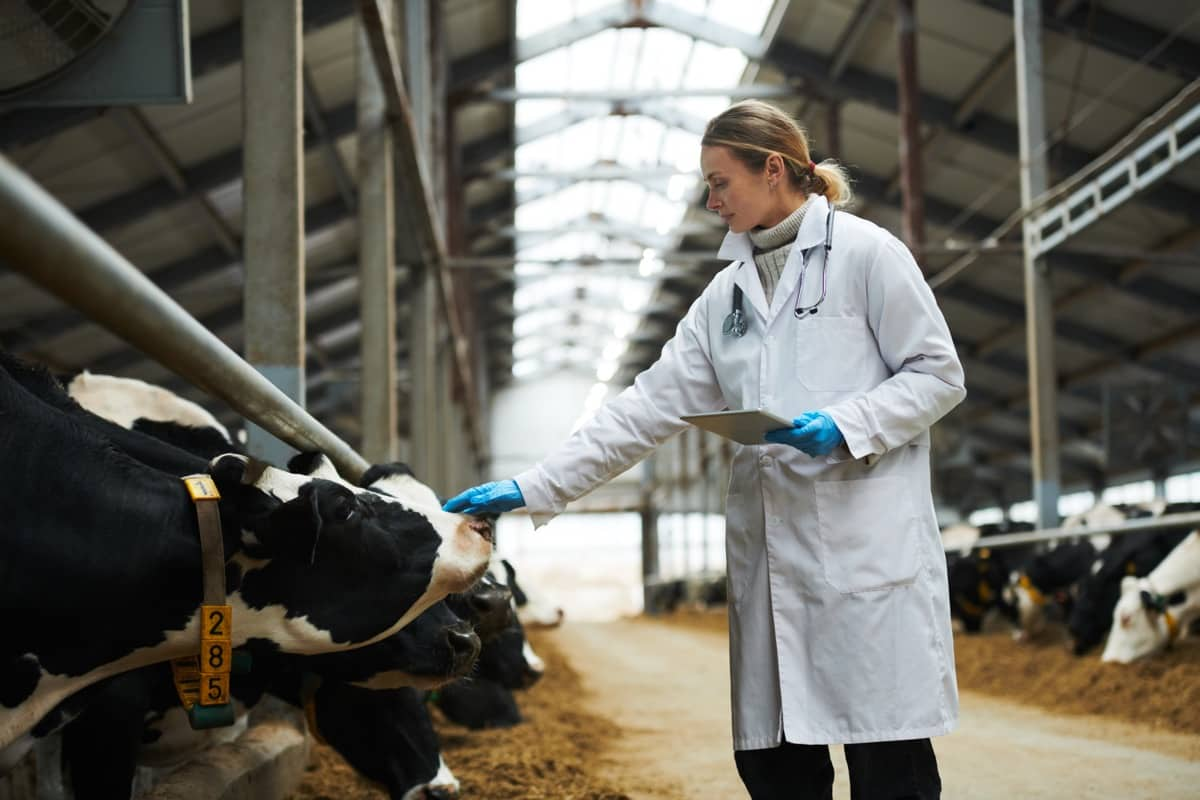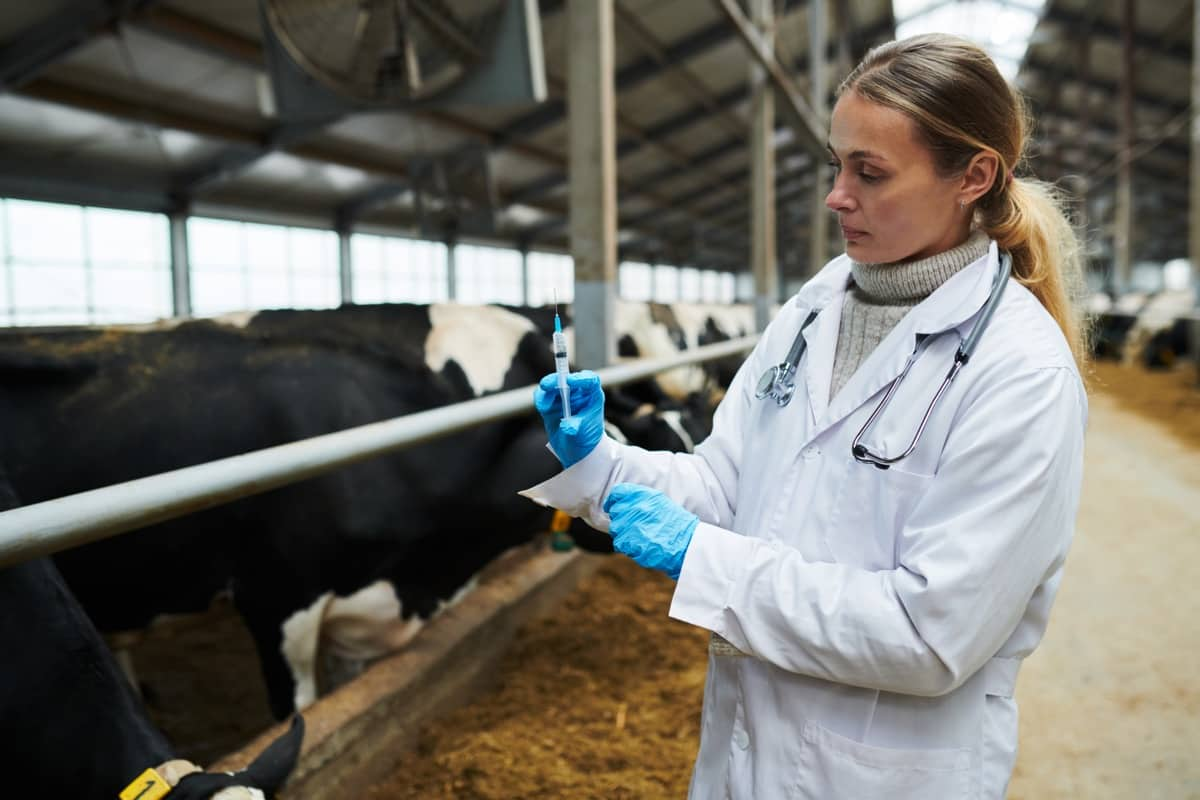Many diseases affect cattle. A high incidence of the disease occurs in herds kept in close quarters, such as on feedlots or large herds kept on a small amount of land. It is also more common for diseases to occur among stressed animals, such as calves that have just been weaned and are being shipped immediately to a new home. Herd management practice of quarantining new animals until you are sure they are not infected can prevent most diseases from being transmitted to your cattle.

10 Common Cattle Diseases
Anthrax
A spore-forming rectangular-shaped bacterium known as Bacillus anthracis causes anthrax, a highly infectious and fatal cattle disease. Ruminants are at risk of acute mortality due to anthrax. Bacteria produce extremely powerful toxins responsible for the ill effects, leading to high mortality rates. After swallowing or inhaling the spores, symptoms usually appear three to seven days later. Two days after signs appear in animals, they usually die.
Affected animals can display fever (106-108°F), loss of appetite, depression, dullness, suspended rumination, rapid pulse, heart rates, and difficulty breathing. It is usually possible to cure anthrax if treated early. Treating anthrax’s cutaneous form (skin) with common antibiotics is possible. In endemic areas, vaccinating animals annually will prevent the disease from spreading.
Foot And Mouth Disease (FMD)
Foot-and-mouth disease affects cloven-footed animals and is highly contagious. It is characterized by blisters and vesicles in the mouth, udder, teats, and between toes and above the hoofs. Animals that have recovered from the disease have characteristically rough coats and deformed hooves. Viruses are spread by direct contact or indirectly through water, manure, hay, and pastures contaminated with the disease. Cattle attendants also convey it. Additionally, it spreads through recovered animals, field rats, porcupines, and birds.
Outbreaks of FMD are usually controlled by quarantines and movement restrictions, euthanasia of affected and infected animals, and cleaning and disinfecting affected premises, equipment, and vehicles. A vaccine can reduce the spread of FMD or protect specific animals. Animals in endemic areas are also protected against clinical diseases by vaccines. There is no guarantee that vaccination with one serotype will protect the animal against other serotypes and may not protect it from other strains of the same serotype at all or completely. There is currently no universal vaccine for FMD.
Bluetongue
Domestic and wild ruminants and camelids are susceptible to bluetongue, transmitted by midges. Cattle may be infected more frequently but do not always exhibit disease symptoms. Midges of Cullicoides species spread the virus between animals. Affected cattle experience nasal discharge, head and neck swelling, conjunctivitis, swelling inside and mouth ulceration, swollen teats, fatigue, saliva drooling, and fever. Apart from rest, soft food, and good husbandry, there is no specific treatment for animals with bluetongue. During recovery, complications, and secondary infections should be treated appropriately.
Bovine Viral Diarrhea
The Bovine Viral Diarrhea Virus (BVDV) causes Bovine Viral Diarrhea (BVD). Suppose susceptible (non-vaccinated) animals become infected with a virulent strain of the virus. Typically, the disease will manifest as an acute, severe illness with bloody diarrhea, high fevers (105-107 degrees Fahrenheit), off-feed, mouth ulcers, and pneumonia. Supportive therapy is the primary treatment for BVD. Identifying infected animals and culling them should be done as soon as possible.
Botulism
The cause of botulism is Clostridium botulinum bacteria, which produce toxins under certain circumstances. There is a risk of botulism in cattle of all ages, characterized by progressive muscle weakness (paralysis). The affected animals may appear weak, stagger, or fall. It is common for cattle to display flaccid paralysis and to protrude their tongues occasionally. The only treatment available for animals affected by botulism is supportive care. There is little reason to use antibiotics since a toxin rather than a bacteria causes the symptoms.
In case you missed it: How to Start Cattle Farming in the USA: Planning, Care, and Management

Johne’s Disease
There is a specific chronic contagious enteritis called Johne’s disease that affects cattle. Johne’s disease in cattle is characterized by weight loss, diarrhea, and a normal appetite. After several weeks of diarrhea, a soft swelling may appear under the jaw. As a result of protein loss from the bloodstream, intermandibular edema, also known as “bottle jaw,” occurs. Affected animals should be segregated and their feces disposed of properly. The incidence of this disease has been reduced by developing a live vaccine.
Milk Fever
It is also called parturient hypocalcemia or parturient paresis and has become increasingly important with heavy milking cows. Generally, the disease occurs in cows between the ages of 5 and 10 years old after calving and is caused by a sudden decrease in blood calcium levels. One to three days after calving, clinical symptoms usually develop.
Symptoms include loss of appetite, constipation, and restlessness, but no rise in body temperature. In case of milk fever, 500 milliliters of 23 percent calcium gluconate IV should be administered, followed by two calcium boluses given 12 hours apart. If cows do not respond to calcium IV treatment, an oral calcium bolus should not be administered.
Foot Rot
Footrot occurs most frequently in cattle on pasture when they must walk through the mud for water and feed. Nevertheless, it can also occur among paddock cattle under seemingly ideal conditions. The infection penetrates between the claws or around the top of the hoof when a cut or scratch occurs on the skin. As directed by a veterinarian, individual cases should be stored in a dry place and treated promptly with medication. Cattle can be forced to walk through a foot bath consists a 5% solution of copper sulfate once or twice a day if the disease becomes a herd problem.
Mastitis
The most common and most expensive disease of dairy cattle is mammary gland inflammation or mastitis. Mastitis is primarily caused by infection by invading bacteria (fungi, yeasts, or viruses), not stress or physical injuries. Ice cubes should be applied to the udder surface once mastitis has been detected. It is advisable to drain infected milk from infested teats three times a day and dispose of it safely. You should prevent calves from sucking on an infected teat. Antibiotic treatment must be initiated immediately after consulting a certified veterinary doctor.
Black Quarter (Black – leg)
Black Quarter is one of the acute infectious and highly fatal bacterial diseases affecting cattle. Sheep, goats, and buffaloes are also affected. The most affected are young cattle aged 6-24 months in good physical condition. Generally, it occurs during the rainy season. In affected cattle, fever (106-10S°F), loss of appetite, depression, dullness, suspended rumination, rapid pulse, heart rate, difficulty breathing, and lameness can be observed.
In case you missed it: Benefits of Cattle Manure Fertilizer in Agriculture: Uses, When and How to Apply

It is recommended that all susceptible cattle be vaccinated and treated prophylactically with penicillin (10,000 IU/kg, IM) to prevent the spread of the infection for at least 14 days following an outbreak. It is recommended that cattle be moved from pastures that are affected.
Conclusion
A high level of disease resistance should be the first health measure you take for your livestock. It is much cheaper to prevent diseases than to treat them, and keeping your cattle healthy can help you raise them faster and easier.
- Feed Your Flock for Less: Top 10 Tips to Save on Chicken Feed
- Ultimate Guide to Ossabaw Island Hog: Breeding, Raising, Diet, and Care
- Hatching Answers: The Top 10 Reasons Your Chickens Aren’t Laying Eggs
- Eggs and Economics: Breaking Down the Cost of Raising Backyard Chickens
- Defend Your Greens: Proven Methods to Keep Iguanas Out of Your Garden
- Ultimate Guide to Cinnamon Queen Chicken: A Comprehensive Guide for Beginners
- Ultimate Guide to California Tan Chicken: Breeding, Raising, Diet, Egg-Production and Care
- Ultimate Guide to Marsh Daisy Chicken: Breeding, Raising, Diet, and Care
- 10 Types of Chicken Farming Businesses You Can Start for Profits